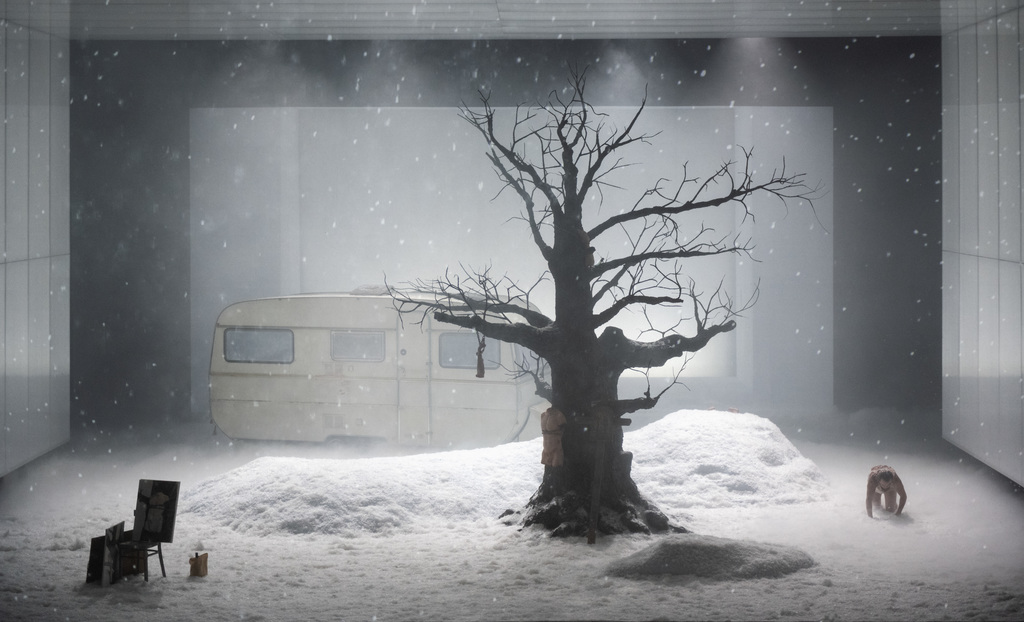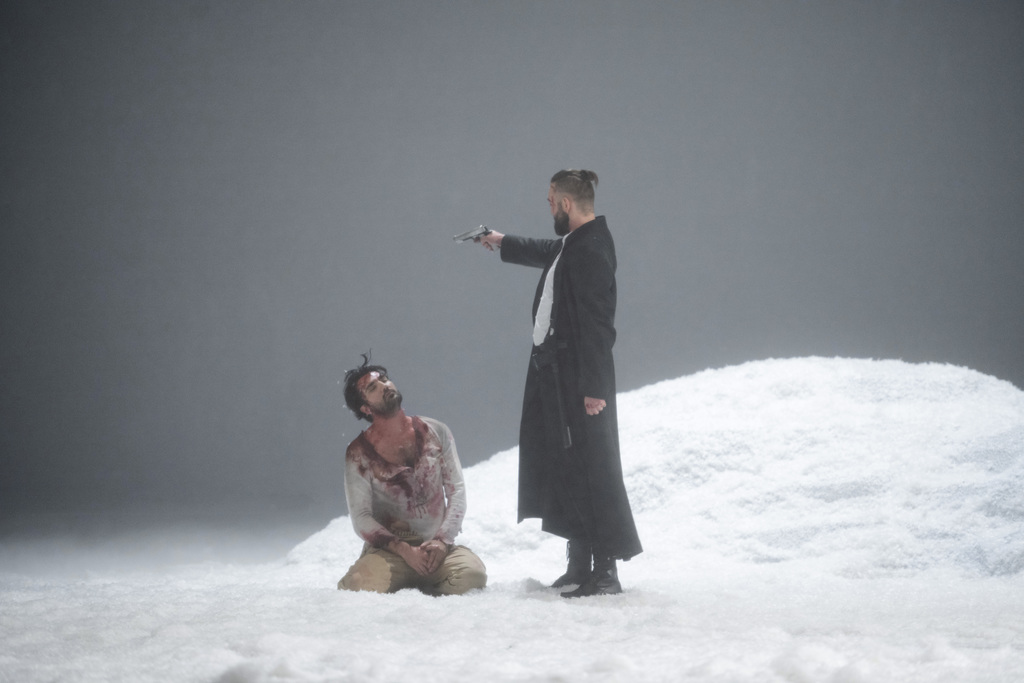
Аn der Wien: Tosca
Театр Ан дер Вин: Тоска
Giacomo Puccini’s “Tosca” premiered in Rome in 1900 and is one of the most important works of verismo. At the Theater an der Wien, Burgtheater director Martin Kušej is now staging this “thriller of violence and great emotion” as, he says, “it has never been seen before.”
Actors
Tosca
Crew
Conductor
Marc Albrecht
Set designer
Annette Murschetz
Costume Designer
Su Sigmund
Lighting Designer
Reinhard Traub
In his production, Latvian soprano Kristīne Opolais, who also repeatedly crosses borders with her playing and with whom Martin Kušej has already successfully collaborated in Rusalka, stands in the crosshairs of politics and art, love and desire as Floria Tosca. Chilean tenor Jonathan Tetelman embodies the politically liberal-minded painter Mario Cavaradossi. Marc Albrecht is at the podium of the ORF Radio Symphony Orchestra Vienna.
Theater an der Wien
Theater an der Wien is not only a place of historical significance where the masterpieces of Mozart and Beethoven were born, but also a place where classical opera performances continue to come to life.
Recording, especially as perfect as today's, allows us to stop time and watch all the best. We can watch outstanding performances from past seasons together. Immerse yourself in the world of music and art in Vienna.
→
Martin Kušej: Theatre of Uncomfortable Questions
The productions of Martin Kušej, the founder of director's theatre, are always a challenge: both for singers and for the audience. His productions, direct and frank, are the calling card of opera houses and festivals – they gather full halls of experts and critics, causing a lot of emotions and debates. TheatreHD presents a selection of the most famous productions of the famous director.
→
ACT I
Cesare Angelotti, a political prisoner, has broken out of the state prison. He frantically hunts for the clothes hidden for him by his sister, Countess Attavanti, and then disappears. Sciarrone, a member of the squad led by the powerful police chief Scarpia, arrives. He sees the easel used by the painter Cavaradossi, but not the painter himself. When Cavaradossi appears, Sciar- rone asks him about the beautiful and unearthly woman whose portrait he sees on the easel. Cavaradossi enthusiastically describes the differences between the unknown lady in the painting and his lover, the singer Floria Tosca.
Angelotti returns. He recognises Cavaradossi as his friend and tells him about his imprisonment and escape. Cavaradossi spontaneously promises to help him. Now Tosca appears and Angelotti has to hide again. The singer is suspicious: she has come to arrange a meeting with her lover and is sure she heard voices. She wants to meet Cavaradossi in his country house after her evening performance. Suddenly she notices a woman she has never seen before but whom her lover has evidently painted. The painter swears that he loves Tosca but does not want to interrupt his work and sends the jealous singer away. In the meantime, Angelotti’s escape from the state prison has been noticed. Cavaradossi describes the well in the garden of his country house as a safe hiding-place and sets off there with the escaped prisoner.
Sciarrone announces a surprise victory over the troops that have occupied the country for so long. The news is greeted with great joy by the police chief’s followers.
The victory celebrations come to an abrupt end when Scarpia appears with Spoletta, one of his agents. He is searching for the escaped Angelotti, and Sciarrone holds women’s clothes out to him. Scarpia recognises the por- trait on the easel and suddenly understands the connection between Cava- radossi and Angelotti. Tosca comes back and is surprised to find that her lover is not there. Scarpia uses the women’s clothes to make her jealous of Countess Attavanti. Greatly upset Tosca hurries to Cavaradossi’s country house to confront the two lovers. The police chief’s henchmen follow her.
ACT II
Scarpia expects Angelotti and Cavaradossi to be arrested and reflects on love, which for him is inseparably linked to violence: In his imagination he sees Cavaradossi killed and the singer in his arms. He hears Tosca singing. He sends a note, summoning her to him. Spoletta returns and tells him that they have arrested Cavaradossi, but not Angelotti. The painter is brought forward and Scarpia interrogates him to find out where Angelotti is hiding, initially without success. When Tosca appears, Cavaradossi manages to whisper to her to keep quiet.
Scarpia hands Cavaradossi over to his torturers. His next attempt to make Tosca jealous of Countess Attavanti and so get her to talk makes no im- pression at all. But when the police chief forces her to listen as her lover moans and screams in agony, she breaks down and reveals where Angelotti is hiding. Scarpia orders the torture to stop and has the prisoner brought in. Cavaradossi is devastated when he realises that his lover has given away his hiding-place and curses her.
News now arrives that the occupying army has won a battle. Cavaradossi rejoices at the prospect of liberation from dictatorship and is led off. Scar- pia now wants to negotiate with Tosca. Contemptuously, she asks what he wants in exchange for Cavaradossi’s life. Scarpia demands her sexual submission. She angrily rejects this condition. But then Scarpia tells her that preparations are already under way for the execution. Spoletta arrives and reports that Angelotti killed himself when he was discovered. When Scarpia demands fulfilment of his condition one last time, Tosca finally nods in agreement.
The police chief then orders Cavaradossi’s execution, adding that – as in the case of another condemned man – it is only to be simulated since he cannot pardon anyone in public. Tosca demands a safe-conduct pass so that she and Cavaradossi are free to leave the country. While Scarpia is writing the document she grabs his knife and buries it in his chest.
ACT III
Cavaradossi is taken to the place of execution, expecting to die. He turns down the offer of confession, asking for permission to write some words of farewell to his beloved. As he writes, he conjures up images of their amo- rous encounters. Now Tosca appears. She tells him what has happened and shows him the safe-conduct pass. She asks him to go along with the fake execution by firing squad, and the two of them fantasise about the rosy futu- re they will share. The firing squad takes aim, and Cavaradossi drops to the ground. Tosca realises to her horror that he really has been killed: Scarpia has deceived her. In the meantime the police chief’s dead body has been discovered. His henchmen approach. In the end, everyone dies.














Monika_Rittershaus.jpg)







